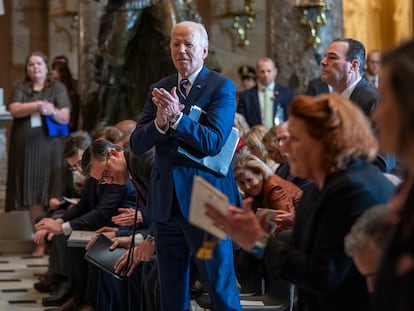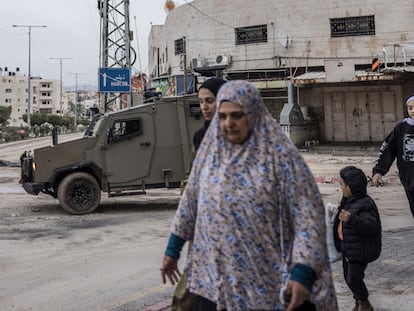Curfews and closed schools: How the war suffocates the Palestinians of Hebron
The residents of this West Bank city, who live in the shadow of 800 Jewish settlers and under watch by 2,500 soldiers, say that they are suffering more degrading treatment since Israel’s offensive on Gaza

Four young Palestinians are kneeling against a wall. Their hands are tied behind their backs with white zip ties. An Israeli soldier guards them, rifle at the ready. There is no shouting, running or altercations. In the orange light of a waning afternoon, a ghostly silence and calm reign. Such scenes have become an everyday anomaly. The old city of Hebron in the West Bank, under permanent military siege, is one of the paradigms of the Israeli occupation of Palestine.
The situation is described as an “apartheid” by Amnesty International and systematically denounced by countless humanitarian organizations. The war that broke out on October 7 has only deepened this perennial spiral of hatred, humiliation and restrictions, according to the Palestinian residents who spoke to EL PAÍS. Their life is marked by the presence of some 800 Jewish settlers, some very violent, who are protected by 2,500 soldiers.
On October 7, when Hamas murdered some 1,200 Israelis, the shockwave of Israel’s military offensive against Gaza was also felt in Hebron. The army decreed a curfew that was only partially lifted two months later after residents took the issue to court. “The first 18 days they kept us locked up, without leaving the house. We couldn’t go to the store for milk, flour or vegetables... We didn’t even have a gas cylinder,” says Yaser Abu Marhia, 52, one of the West Bankers who filed a complaint with the help of a lawyer.
But Israel, he explains, did not recognize that it was carrying out “collective punishment” — as several of those interviewed also described it. For days, Israel only opened some parts of the city for short periods at 7 a.m. and 7 p.m. “You had to stay away from home for those 12 hours, even if you had gone out to get something in five minutes,” he complains. Today, with the war in its fifth month, there are still military checkpoints that remain closed 24 hours a day.
Four schools — where a thousand students used to go — have been closed since October 7, says official Anan Dana, from his office at the headquarters of the Palestinian Ministry of Education. Meanwhile, in a daycare center in the Tel Rumeida neighborhood, only nine of its 40 students were able to get there due to the blockade. “They use the curfew as they please on a daily basis. The restriction of movement affects teachers who come from outside, who are the majority. The education system is falling apart,” he says.
On January 16, Haya Tanineh was heading to the school where she teaches. She left her car as far as it was authorized to go and walked towards one of the military checkpoints. A few meters before getting there, she decided to take out her cell phone and record a video. “They held me for three hours,” explains Haya, who is tired of spending two hours a day getting to work, when the trip took 30 minutes before the war.
In 1997, Hebron was divided into two zones. Most of the city’s 200,000-strong population lives in the H1 area (85% of the city), where the Palestinian Authority (PA) is in control of security. The direct victims of most of the restrictions are the 35,000 residents of H2 (15%), where the Old City of Hebron is located. In this area, Israel controls security. Life there takes place amid a network of military checkpoints, barriers, barbed wire, concrete blocks, surveillance cameras...
Jewish settlements absorb West Bank homes
Shfila is one of the checkpoints that has been closed to residents since the start of the war in Gaza. It overlooks a hill between H1 and H2, on which the graves of a Jewish cemetery slope down. There, Yaser Abu Marhia and his neighbor Sheher Abu Aisha, 64, point to a mast flying an Israeli flag in the Tel Rumeida neighborhood, in H2. The two explain that their home is located in that neighborhood, but has been practically absorbed by Jewish settlements.
The military checkpoints are concrete and barred fortresses equipped with metal detectors and surveillance cameras. With more than 300,000 Israeli reservists called up for war, some of these checkpoints, Abu Marhia argues, have been taken over by radical settlers who now wear uniforms.
These two men have not been able to drive to their home in two decades, just like the other inhabitants of H2. The Jewish settlers do not have the same problem. Abu Marhia pulls up photos on his phone showing Israeli soldiers and settlers using the land around his home as a parking lot. “This is how we live,” he says.
Fawaz Abu Aisha, Sheher’s brother and a 40-year-old civil servant, looks at an aerial photo of the city and counts the military checkpoints until he gets to 25. Israel’s 20-year-long chokehold on Hebron has tightened due to the war in Gaza. “Since October 7 we have suffered more humiliation, more restrictions and more curfews… The military is acting more aggressively. We are living under a settler government,” says Badee Dwaik, a local human rights activist.
Painted with the star of David
Getting through the occupied West Bank and into H2 requires a 12-mile detour. After passing the Jewish settlement of Kiryat Arba, the road leads through several military barriers to the old city of Hebron. “We will win in Gaza,” reads graffiti next to the Star of David, a symbol of Judaism, on the walls of the UNESCO World Heritage Site.
In the Old City of Hebron, some 800 Jewish settlers are shoehorned in and protected by an estimated 2,500 soldiers, according to Badee Dwaik. Israelis are allowed to move freely in the area, in and out of uniform. Some visitors, also Jews, arrive to visit the Tomb of the Patriarchs (known by Muslims as the Sanctuary of Abraham), a sacred place for the three monotheistic religions, which Israel controls, like the rest of the Old City. The EL PAÍS reporter is allowed to enter after a soldier asks him about his religious beliefs. Only when it is clear he is not Muslim, is he allowed to go in.
“I only came to help my sacred nation,” explains Yusef, 60, a Jew and former soldier of the Soviet Red Army, who became a naturalized citizen of the United States, from where he traveled to Israel for the first time as a volunteer. Asked about the tense coexistence caused by Israel’s occupation of Hebron, he replies: “In every generation, someone always tries to kill us. The Spanish Inquisition, Hitler, Stalin… They will all fail.”
Israel has taken advantage of the war in Gaza “to execute its settlement and Judaization plan, imposing a curfew on the population of the blockaded areas and isolating them,” said Emad Hamdan, director of the Hebron Rehabilitation Committee (HRC), a Palestinian institution that seeks above all to safeguard the Old City, during the first days of the conflict.
Palestinians in H2 “routinely endure violence, nightly military excursion into their homes, harassment, delays at checkpoints and various forms of degrading treatment,” reports Israeli humanitarian organization B’Tselem on its website. “Violent conduct by settlers has also become routine in the area.” Last May, Amnesty International accused Israel of using facial recognition technology to entrench the “apartheid” against Palestinians.
In the surrounding area, children wearing the kippah run around with backpacks as they leave school, giving a picture of false normality. Some buses and cars come and go through the streets that ascend towards Kiryat Arba. Muslims, always on foot, have a minimal presence. They are seen entering and leaving through the metal turnstiles that lead to H1. Stores are closed. In the upper part of H2, a handful of Palestinian kids play soccer, giving an impression of everyday life.
Yaser Abu Marhia regrets the harsh conditions under which they live, but is not considering leaving Hebron, as some inhabitants have done due to the Israeli restrictions. “I’m going to die here,” he says twice. It’s a sentence his 90-year-old grandmother often repeats, and one that he has made his own.
Sign up for our weekly newsletter to get more English-language news coverage from EL PAÍS USA Edition
Tu suscripción se está usando en otro dispositivo
¿Quieres añadir otro usuario a tu suscripción?
Si continúas leyendo en este dispositivo, no se podrá leer en el otro.
FlechaTu suscripción se está usando en otro dispositivo y solo puedes acceder a EL PAÍS desde un dispositivo a la vez.
Si quieres compartir tu cuenta, cambia tu suscripción a la modalidad Premium, así podrás añadir otro usuario. Cada uno accederá con su propia cuenta de email, lo que os permitirá personalizar vuestra experiencia en EL PAÍS.
¿Tienes una suscripción de empresa? Accede aquí para contratar más cuentas.
En el caso de no saber quién está usando tu cuenta, te recomendamos cambiar tu contraseña aquí.
Si decides continuar compartiendo tu cuenta, este mensaje se mostrará en tu dispositivo y en el de la otra persona que está usando tu cuenta de forma indefinida, afectando a tu experiencia de lectura. Puedes consultar aquí los términos y condiciones de la suscripción digital.
More information
Archived In
Últimas noticias
There is as much life left to discover on planet Earth as that which is already known
Dozens presumed dead, around 100 injured in fire at Swiss Alps bar during New Year’s celebration
Is porn for women different from conventional porn? We spoke to those who make it
Cartagena de Indias is sinking: What can the city do to mitigate it?
Most viewed
- Sinaloa Cartel war is taking its toll on Los Chapitos
- Reinhard Genzel, Nobel laureate in physics: ‘One-minute videos will never give you the truth’
- David King, chemist: ‘There are scientists studying how to cool the planet; nobody should stop these experiments from happening’
- Oona Chaplin: ‘I told James Cameron that I was living in a treehouse and starting a permaculture project with a friend’
- The Interoceanic Train, the Mexican alternative to the Panama Canal











































